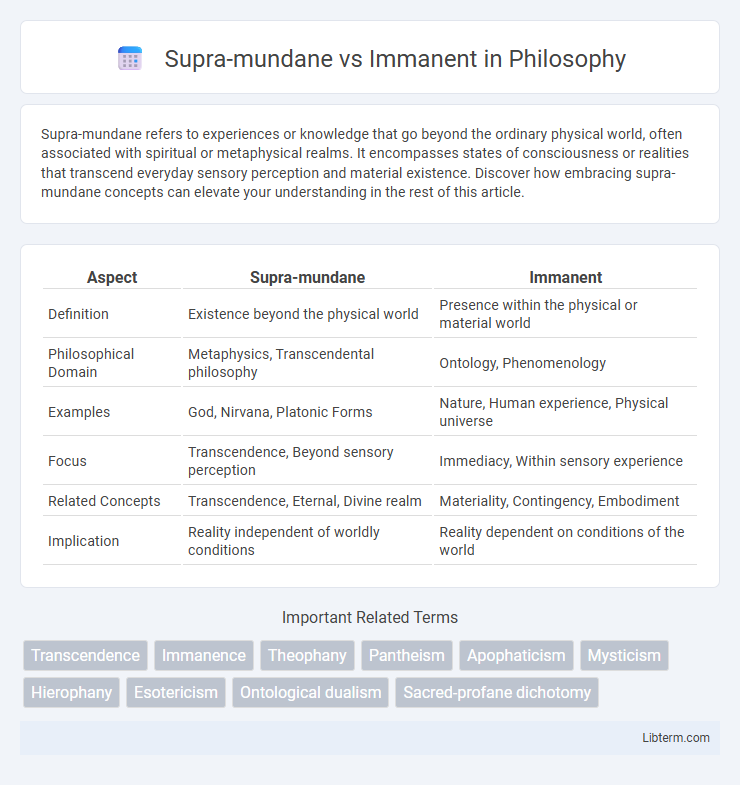Supra-mundane refers to experiences or knowledge that go beyond the ordinary physical world, often associated with spiritual or metaphysical realms. It encompasses states of consciousness or realities that transcend everyday sensory perception and material existence. Discover how embracing supra-mundane concepts can elevate your understanding in the rest of this article.
Table of Comparison
| Aspect | Supra-mundane | Immanent |
|---|---|---|
| Definition | Existence beyond the physical world | Presence within the physical or material world |
| Philosophical Domain | Metaphysics, Transcendental philosophy | Ontology, Phenomenology |
| Examples | God, Nirvana, Platonic Forms | Nature, Human experience, Physical universe |
| Focus | Transcendence, Beyond sensory perception | Immediacy, Within sensory experience |
| Related Concepts | Transcendence, Eternal, Divine realm | Materiality, Contingency, Embodiment |
| Implication | Reality independent of worldly conditions | Reality dependent on conditions of the world |
Understanding the Supra-mundane: Definition and Origins
The supra-mundane refers to realities or entities existing beyond the physical, sensory world, often associated with spiritual or transcendental realms. Rooted in religious and philosophical traditions, the term originates from Latin "supra," meaning "above," and "mundane," meaning "worldly," highlighting its contrast to immanent phenomena confined within the material universe. Understanding the supra-mundane involves exploring metaphysical concepts such as the divine, ultimate truths, and the nature of consciousness beyond empirical experience.
The Immanent: Conceptual Overview
The immanent refers to the presence of the divine or ultimate reality within the natural world and human experience, emphasizing an intrinsic connection rather than external transcendence. Philosophically, immanence asserts that all aspects of existence are permeated by spiritual or metaphysical significance without recourse to entities beyond observable reality. This concept is central to many pantheistic and panentheistic traditions, highlighting an inherent unity between the cosmos and its underlying essence.
Historical Perspectives: Supra-mundane vs Immanent
Historical perspectives on supra-mundane versus immanent concepts highlight a longstanding philosophical debate about the nature of reality and divinity. Supra-mundane views, prominent in Platonic and Neoplatonic traditions, posit a transcendent realm beyond the physical world, while immanent perspectives, found in Stoicism and later in Spinoza's philosophy, emphasize the divine or ultimate reality as inherent within the material world. This dichotomy has shaped theological and metaphysical discussions across civilizations, influencing interpretations of existence, spirituality, and the cosmos.
Key Philosophical Differences
Supra-mundane refers to realms or realities that exist beyond the physical world, often transcending sensory experience and empirical knowledge, while immanent pertains to the presence or existence within the material universe and natural phenomena. Key philosophical differences include the nature of existence, where supra-mundane entities are often considered eternal and unchanging, contrasted with immanent realities that are temporal and subject to change. Epistemologically, supra-mundane knowledge is acquired through spiritual insight or revelation, whereas immanent knowledge depends on observation and reason within worldly contexts.
Supra-mundane in Religious Contexts
Supra-mundane entities in religious contexts refer to divine or transcendent beings and realms that exist beyond the physical world, such as gods, angels, or nirvana in various faith traditions. These entities often embody ultimate reality or spiritual perfection, serving as objects of worship and sources of moral authority. The concept underscores a distinction between the temporal, immanent world and an exalted, eternal existence beyond ordinary human experience.
Immanence in Spiritual and Secular Thought
Immanence denotes the presence of the divine or ultimate reality within the material world and human experience, contrasting with supra-mundane concepts that situate the sacred beyond physical reality. In spiritual traditions, immanence emphasizes the accessibility of the divine through inner experience, meditation, and ethical living, fostering a direct and personal relationship with the sacred. Secular thought applies immanence by recognizing meaning, value, and consciousness as inherent to the natural world, rejecting transcendent explanations and affirming human creativity and social structures as sources of purpose.
Supra-mundane and Immanent in Modern Philosophy
Supra-mundane concepts in modern philosophy refer to realities or entities existing beyond the physical world, often associated with metaphysical or transcendent dimensions, as emphasized by thinkers like Kant who posited noumena beyond sensory experience. Immanent philosophy, conversely, focuses on meanings, causes, and realities contained within the material and experiential world itself, as seen in Spinoza's monism and Deleuze's emphasis on immanence as the foundation of reality. The tension between supra-mundane and immanent perspectives shapes contemporary debates on the nature of existence, consciousness, and knowledge in modern philosophical discourse.
Relevance in Contemporary Society
Supra-mundane concepts, referring to realities beyond the physical world, influence contemporary spirituality by encouraging individuals to seek transcendent meaning beyond material existence. Immanent perspectives, grounded in the belief that divinity or ultimate reality exists within the natural world and human experience, resonate with modern movements emphasizing mindfulness, environmentalism, and social justice. The relevance of these contrasting views shapes ethical frameworks and personal fulfillment strategies amidst rapid technological and cultural change.
Interplay and Integration: Bridging the Divide
Supra-mundane and immanent realities represent distinct dimensions of existence, where supra-mundane refers to transcendent, beyond-worldly realms, and immanent pertains to the inherent, internal presence within the physical world. The interplay and integration of these concepts highlight a dynamic relationship where transcendent truths inform and enrich immanent experience, fostering a holistic understanding of existence. Bridging this divide involves recognizing the continuous interaction between higher metaphysical principles and everyday consciousness, promoting a synthesis that transcends dualistic separation.
Conclusion: Future Discourse and Implications
Future discourse on supra-mundane versus immanent concepts will likely emphasize the integration of metaphysical and empirical perspectives, enhancing philosophical and theological dialogues. Emerging interdisciplinary research in cognitive science and spirituality could reshape understandings of reality beyond purely material dimensions. Such developments may influence ethical frameworks and societal structures by bridging transcendental insights with everyday experience.
Supra-mundane Infographic

 libterm.com
libterm.com